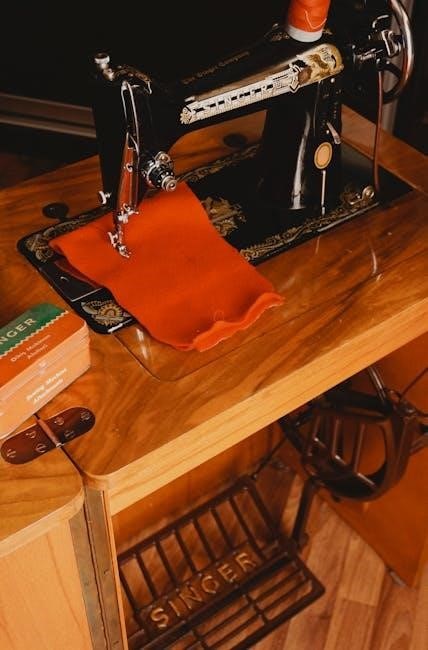The Singer 401A manual is essential for understanding and maintaining this versatile sewing machine․ It provides detailed guidance on operation, maintenance, and troubleshooting, ensuring optimal performance and longevity․
Overview of the Singer 401A Sewing Machine
The Singer 401A is a durable, all-metal sewing machine known for its versatility and reliability; Produced in the 1960s, it features a robust design with no plastic parts, making it a workhorse for home sewing projects․ Its slant-o-matic™ feature enhances visibility, while multiple stitch patterns offer flexibility for various fabrics; The machine is ideal for tasks like piecing, appliqué, and free-motion quilting․ Its metal construction ensures longevity, but regular maintenance, such as oiling and cleaning, is essential for optimal performance․ The Singer 401A is a popular choice among sewists due to its ease of use and adaptability for both light and heavy fabrics․
Importance of the Manual for Proper Usage
The Singer 401A manual is crucial for mastering the machine’s features and ensuring proper functioning․ It provides step-by-step instructions for threading, bobbin setup, and troubleshooting common issues like thread breakage or motor noise․ Regular maintenance, such as cleaning and oiling, is detailed to prevent wear and tear․ The manual also highlights best practices for using compatible needles and accessories, optimizing stitch quality, and addressing tension problems․ By following the guide, users can extend the machine’s lifespan and achieve professional results․ Whether you’re a novice or experienced sewer, the manual is an indispensable resource for unlocking the Singer 401A’s full potential․
Key Features of the Singer 401A
The Singer 401A boasts an all-metal construction, offering durability and reliability․ It features multiple stitch patterns, a Slant-O-Matic™ needle for improved visibility, and a robust motor for heavy-duty sewing․
All-Metal Construction and Durability
The Singer 401A stands out with its all-metal construction, ensuring exceptional durability and longevity․ Unlike modern machines with plastic parts, the 401A’s metal framework withstands heavy use and resists wear․ This robust build makes it ideal for demanding projects, including heavy fabrics like denim and canvas․ Users praise its reliability, as it maintains consistent performance over years with proper maintenance․ The absence of plastic components not only enhances its sturdiness but also contributes to smoother operation, making it a favorite among sewists who value longevity and reliability in their sewing machines․
Multiple Stitch Patterns and Versatility
The Singer 401A offers 29 built-in stitches, including straight, zigzag, and decorative patterns, providing versatility for various sewing projects․ Its cam-driven system allows easy switching between stitches, enabling users to tackle everything from basic repairs to intricate designs․ The machine excels at handling different fabrics, from delicate cotton to heavy-duty materials, making it a versatile choice for both beginners and experienced sewists․ Additionally, the 401A supports free-motion quilting and other advanced techniques, further enhancing its adaptability․ With interchangeable presser feet for specialized tasks, this machine caters to a wide range of sewing needs, ensuring precision and creativity in every stitch․
Slant-O-Matic™ Feature for Improved Visibility
The Singer 401A features the innovative Slant-O-Matic™ design, which offers an unobstructed view of the sewing area․ This unique feature allows users to easily monitor their work as they sew, enhancing accuracy and control․ The slanting needle mechanism improves visibility, making it easier to align fabrics and track stitches in real-time․ This ergonomic design reduces eye strain and makes sewing more comfortable, especially during lengthy projects․ The Slant-O-Matic™ feature is a standout attribute of the 401A, contributing to a more efficient and enjoyable sewing experience for crafters and professionals alike․

Setting Up the Singer 401A
Setting up the Singer 401A involves unpacking, inspecting, and positioning the machine on a stable surface․ Ensure all components are accounted for and the area is clear for optimal functionality․
Unpacking and Initial Inspection
When unpacking the Singer 401A, carefully remove all components from the box․ Inspect the machine for any visible damage or wear․ Check for all included accessories, such as bobbins, needles, and the instruction manual․ Ensure the power cord and foot pedal are intact․ Examine the exterior and interior for dust or debris․ Gently wipe down surfaces with a soft cloth if necessary; Verify that all mechanical parts move smoothly, including the handwheel and stitch selectors․ This initial inspection ensures everything is in working order before first use, helping to prevent future issues․
Understanding the Machine’s Components
Familiarizing yourself with the Singer 401A’s components is crucial for effective operation․ The machine features a sturdy all-metal construction, including a handwheel for manual control and a stitch selector dial for choosing patterns․ The bobbin case, tension dials, and presser foot are essential for threading and fabric guidance․ The motor, housed inside, powers the mechanism, while the take-up lever adjusts stitch length․ Understanding each part’s function ensures proper setup and operation․ This knowledge also aids in identifying and addressing potential issues, making you more self-sufficient in maintaining and using the machine effectively․
Placing the Machine on a Stable Work Surface
Positioning the Singer 401A on a stable, flat work surface is essential for smooth operation․ Ensure the surface is level to prevent uneven stitching and vibrations․ A sturdy table or dedicated sewing cabinet is ideal, as the machine is heavy and requires a firm base․ Avoid placing it near direct sunlight or moisture to protect its metal components․ Keep the machine away from clutter to allow easy access and movement․ Proper placement enhances sewing accuracy and reduces the risk of mechanical stress․ Ensure good lighting nearby for visibility, and maintain space around the machine for comfortable fabric handling and control․

Threading and Bobbin Setup
Proper threading and bobbin setup are crucial for the Singer 401A’s performance․ Follow the manual’s step-by-step guide to ensure smooth stitching and prevent thread breakage or tangles․
Step-by-Step Guide to Threading the Machine
Begin by placing the thread on the spool pin and guide the end through the tension discs;
Insert the thread into the take-up lever, ensuring it clicks into place․
Gently pull the thread to test tension and confirm it moves smoothly․
Thread the needle from front to back, then pull the thread to secure it․
For the bobbin, wind the thread evenly and insert it into the bobbin case․
Pull the thread tail to seat the bobbin properly․
Always refer to the manual for specific threading diagrams and adjustments․
Proper threading ensures consistent stitching and prevents machine issues․
Winding and Installing the Bobbin Correctly
To wind the bobbin, place the thread on the spool pin and guide it through the tension spring․ Wind the thread evenly around the bobbin, leaving a small loop at the end․ Cut the thread and secure it by pulling gently․ For installation, insert the bobbin into the bobbin case, ensuring it aligns properly․ Pull the thread tail to seat the bobbin firmly․ Ensure the bobbin is not overfilled and the thread is taut but not overly tight․ Properly wound and installed bobbins prevent thread breakage and ensure smooth stitching․ Refer to the manual for specific winding and installation diagrams․
Troubleshooting Common Threading Issues
If the thread does not flow smoothly, check for twists or tangles․ Ensure the spool is correctly seated and the thread path is clear․ If the machine skips stitches, inspect the needle for damage or improper installation․ Correct any misalignment in the tension discs and ensure the bobbin is properly seated․ If thread breaks frequently, adjust the upper tension or replace the needle․ Lubricate moving parts regularly to prevent friction-related issues․ Always refer to the Singer 401A manual for step-by-step guidance on resolving threading problems and maintaining optimal sewing performance․

Basic Sewing Operations
The Singer 401A manual outlines essential steps for basic sewing, including setting up the machine, selecting stitches, and guiding fabric smoothly for consistent results and quality stitching․
Starting Your First Sewing Project
Begin by preparing your Singer 401A, ensuring it is properly threaded and the bobbin is correctly installed․ Choose your fabric and stitch pattern, then align the fabric under the presser foot․ Start with a straight stitch for simplicity․ Guide the fabric smoothly, maintaining even tension․ If the needle thread breaks, check for tangles or improper threading․ Practice on scrap fabric before sewing your final project․ Keep the work area clear and well-lit for better visibility․ The machine’s durability and stitch quality make it ideal for beginners and experienced sewists alike, ensuring your first project is a success․
Using the Stitch Selector and Controls
The Singer 401A features a user-friendly stitch selector dial, allowing you to choose from various stitch patterns; Rotate the dial to select your desired stitch, ensuring it aligns with the indicator․ Use the stitch length and width controls to adjust settings for different fabrics․ The machine also includes a reverse stitch lever for reinforcing seams․ Always test stitches on scrap fabric before sewing your final project․ The intuitive controls make it easy to explore decorative and functional stitches, enhancing your sewing experience․ Proper use of these features ensures professional-quality results for both beginners and experienced sewists․
Guiding Fabric for Smooth Stitching
Guiding fabric smoothly is crucial for even stitching․ Use the built-in edge guide or attach a seam guide to maintain consistent seam allowances․ Keep fabric taut but not stretched․ For delicate fabrics, use a walking foot or Teflon foot for better control․ When sewing curves, gently guide the fabric without pulling․ Use the free arm for cylindrical items like sleeves․ Always align the fabric edge with the guide, ensuring straight lines․ Proper fabric handling reduces bunching and ensures precise stitching, making your sewing projects look professional․

Maintenance and Lubrication
Regular maintenance ensures the Singer 401A runs smoothly․ Clean dust and debris, lubricate moving parts, and inspect for wear․ Proper care extends machine life and performance․
Cleaning the Machine Regularly
Regular cleaning is crucial for maintaining the Singer 401A’s performance․ Use a soft cloth to wipe down the exterior and remove dust from the interior․ Pay attention to the bobbin area and tension discs, as lint and debris can accumulate there․ For stubborn dirt, a Q-tip lightly dampened with rubbing alcohol can clean small crevices․ Avoid harsh chemicals, as they may damage the machine’s finish․ After cleaning, apply a few drops of sewing machine oil to moving parts․ This routine prevents rust and ensures smooth operation․ Regular maintenance keeps the Singer 401A in excellent condition, ready for years of reliable service․
Applying Sewing Machine Oil Properly
Properly lubricating the Singer 401A is essential for its smooth operation․ Begin by turning off the machine and ensuring it is clean․ Locate the oil ports, typically found on the machine’s side or near the bobbin area․ Use high-quality sewing machine oil, applying a few drops to each port․ Gently turn the handwheel to circulate the oil throughout the internal mechanisms․ Avoid over-lubrication, as excess oil can attract dust and cause maintenance issues․ Regular oil application ensures all moving parts run efficiently, preventing friction and wear․ Refer to the manual for specific locations and frequency of lubrication for optimal performance․
Inspecting and Replacing Worn Parts
Regular inspection of the Singer 401A ensures longevity and performance․ Check the bobbin case, hooks, and feed dogs for wear․ Examine the needle bar and presser foot for alignment issues․ Look for signs of wear on the tension discs and take-up lever․ If parts are damaged or worn, replace them promptly using Singer-approved components․ Lubricate new parts before installation․ Refer to the manual for diagrams and instructions․ Replacing worn parts prevents further damage and maintains stitching quality․ Keep spare needles and other frequently used parts on hand to avoid delays during projects․ Proper maintenance ensures the machine continues to function reliably over time․

Troubleshooting Common Issues
The Singer 401A manual offers solutions for common problems like thread breakage, uneven stitching, and motor noise․ Regular maintenance and proper threading often resolve these issues quickly․
Identifying and Fixing Tension Problems
Tension issues on the Singer 401A often cause uneven stitching or thread breakage․ Check the top and bobbin thread tension dials․ If stitches are too tight, loosen the tension slightly․ If too loose, tighten it; Ensure the bobbin is correctly seated and threaded․ Improper threading can lead to inconsistent tension․ Clean the tension discs regularly to remove lint or debris․ If problems persist, refer to the manual for specific adjustment guidelines․ Proper tension ensures smooth stitching and optimal machine performance․
Resolving Needle Thread Breakage
Needle thread breakage on the Singer 401A can be frustrating but is often fixable․ First, check if the thread is properly threaded through the machine, ensuring it passes correctly through the tension discs and take-up lever․ Verify that the needle is installed correctly and aligned with the machine’s hook․ Using the wrong needle size or type can also cause breakage․ If issues persist, adjust the top tension or ensure the bobbin thread is not tangled․ Regularly cleaning lint from the needle area and re-threading the machine can prevent recurring problems․ Proper maintenance ensures smooth stitching and reduces thread breakage․
Addressing Motor Speed and Noise Concerns
Motor speed and noise issues with the Singer 401A can often be resolved by checking the belt tension and ensuring proper lubrication․ If the motor runs slowly or erratically, inspect the belt for wear or misalignment and adjust it as needed․ Excessive noise may indicate insufficient oil or debris buildup in the motor area․ Regularly cleaning and lubricating the motor according to the manual’s instructions can help maintain smooth operation․ Additionally, ensuring the machine is placed on a stable surface and avoiding overload can prevent speed fluctuations․ Proper maintenance and periodic servicing can extend the motor’s lifespan and reduce noise․

Advanced Sewing Techniques
The Singer 401A excels in free motion quilting, handles heavy fabrics effortlessly, and offers decorative stitch patterns for intricate designs, making it ideal for advanced sewing projects․
Mastering Free Motion Quilting
Mastering free motion quilting on the Singer 401A requires practice and precision․ Start by dropping the feed dogs and attaching a darning foot for better fabric control․ Adjust the tension to ensure even stitches․ Practice on scrap fabric to refine your technique․ Use a steady, smooth motion to create intricate patterns․ The 401A’s all-metal construction and consistent stitch quality make it ideal for free motion work․ Experiment with different thread weights and colors to enhance your designs․ Keep the fabric taut but not overly tight to avoid distortion․ With patience, you can achieve professional-looking quilts and custom stitching․
Using the Singer 401A for Heavy Fabrics
The Singer 401A excels with heavy fabrics like denim, canvas, and leather due to its robust all-metal construction․ For optimal results, use heavy-duty needles and adjust the presser foot tension to accommodate thicker materials․ A walking foot or Teflon foot can enhance control, preventing fabric drag․ Ensure proper thread selection to match fabric weight․ The machine’s consistent stitch quality and powerful motor handle heavy-duty projects effortlessly, making it ideal for sewing durable items like bags or upholstery․ Regular maintenance, including oiling and cleaning, is crucial to maintain performance when working with demanding fabrics․ This versatility solidifies the Singer 401A as a reliable choice for heavy-duty sewing tasks․
Exploring Decorative Stitch Patterns
The Singer 401A offers a variety of decorative stitch patterns, perfect for enhancing creativity in sewing projects․ Users can explore intricate designs, from simple straight stitches to elaborate floral and geometric patterns․ The machine’s stitch selector allows easy navigation between different styles, while adjustable length and width settings enable customization․ Experimenting with decorative threads and fabrics can further enhance the visual appeal of stitched designs․ Whether crafting home decor, garments, or quilts, the Singer 401A’s diverse stitch library provides endless possibilities for personalization and artistic expression, making it a valuable tool for both beginners and experienced sewists seeking to elevate their projects․

Comparing with Other Singer Models
The Singer 401A stands out among other Singer models like the 301 and 500A for its all-metal construction, durability, and versatility, making it ideal for home sewing enthusiasts․
Differences Between Singer 301, 401A, and 500A
The Singer 301, 401A, and 500A are popular sewing machines, each with unique features․ The Singer 301 is a basic, lightweight model suitable for simple sewing tasks․ The Singer 401A, known for its durability, offers multiple stitch patterns, a slant-incline feature, and an all-metal frame, making it versatile for both home and small-scale professional use․ The Singer 500A includes additional features like automatic buttonholes and a wider range of stitches but is slightly heavier and more expensive․ The Singer 401A is often preferred for its balance of affordability, durability, and functionality, making it a favorite among home sewists and hobbyists alike․
Why the Singer 401A is Preferred for Home Use
The Singer 401A is a preferred choice for home use due to its compact design, ease of operation, and versatility․ Its all-metal construction ensures durability, while the variety of stitch patterns and straightforward controls make it ideal for both beginners and experienced sewists․ The machine’s slant-incline feature enhances visibility, allowing for precise stitching․ Additionally, it is relatively lightweight and easy to maintain, with a robust motor that handles various fabrics effectively; Its affordability and reliability make it a practical option for home sewers, offering professional-quality results without the need for advanced features, making it a timeless favorite in many households․
Comparison with Modern Sewing Machines
The Singer 401A stands out for its simplicity and durability compared to modern sewing machines․ While modern machines offer advanced features like computerized controls and automatic threading, the 401A’s all-metal construction and mechanical design provide unparalleled reliability․ Modern machines often include more stitch options and automated functions, but the 401A excels in its straightforward operation and ease of maintenance․ Its robust build and timeless design make it a favorite among hobbyists and professionals alike, offering a dependable option for those who value durability over high-tech features․ The 401A remains a practical choice for home use, blending classic craftsmanship with essential functionality․

Accessories and Compatibility
Essential accessories for the Singer 401A include compatible needles, presser feet, and additional attachments․ These enhance functionality and compatibility, allowing users to explore various sewing techniques and projects effectively․
Essential Accessories for the Singer 401A
The Singer 401A requires specific accessories to optimize its performance․ These include high-quality sewing needles, such as sharp, heavy-duty, or leather needles, depending on the fabric type․ Additionally, presser feet like the zipper foot, buttonhole foot, and walking foot are indispensable for specialized tasks․ Bobbins designed for the 401A ensure smooth stitching and prevent thread jams․ Other essentials include seam rippers, measuring tapes, and screwdriver sets for maintenance․ Using genuine or compatible Singer parts guarantees durability and compatibility, ensuring the machine operates efficiently and maintains its longevity․ These accessories are readily available online or through sewing supply stores․
Using Compatible Needles and Feet
Using compatible needles and feet is crucial for optimal performance of the Singer 401A․ Select needles based on fabric type—sharp for woven fabrics, heavy-duty for thick materials, and leather needles for heavy-duty projects․ Presser feet, such as the zipper foot or buttonhole foot, are designed for specific tasks and ensure precise stitching․ Always use Singer-recommended accessories to maintain compatibility and prevent damage․ Incorrect needles or feet can cause thread breakage or uneven stitching․ Regularly inspect and replace worn needles to ensure smooth operation and extend the machine’s lifespan․ Compatible accessories are widely available and essential for achieving professional results․
Upgrading with Additional Attachments
Upgrading the Singer 401A with additional attachments enhances its functionality and versatility․ Optional attachments like rufflers, gathering feet, or edge joiners expand the range of sewing tasks․ These attachments are designed to fit seamlessly with the machine’s existing components․ Users can explore various Singer-approved add-ons to customize their sewing experience․ Upgrading allows for more intricate stitching, improved fabric handling, and increased creativity․ Always refer to the manual for installation guidelines to ensure proper fit and function․ By investing in quality attachments, sewists can unlock the full potential of their Singer 401A, making it a go-to machine for diverse projects and techniques․

Community and Resources
The Singer 401A community offers extensive support through online forums, YouTube tutorials, and downloadable manuals, providing invaluable resources for users to master their sewing skills effectively․
Online Forums and Communities for Support
Online forums and communities dedicated to the Singer 401A provide invaluable support for users․ These platforms offer troubleshooting tips, maintenance advice, and shared experiences from seasoned sewists․ Many enthusiasts discuss common issues like thread breakage and tension problems, offering practical solutions․ Additionally, communities often share links to downloadable manuals and recommend YouTube tutorials for visual guidance․ Users can also connect with experts and hobbyists to resolve specific queries, making these forums a go-to resource for optimizing the machine’s performance and addressing any challenges that arise during use․ The collective knowledge of these communities ensures users can fully utilize their Singer 401A’s capabilities․
Recommended YouTube Tutorials and Guides
YouTube offers an array of tutorials and guides dedicated to the Singer 401A, providing step-by-step instructions for various operations․ Videos cover essential tasks like threading, bobbin setup, and troubleshooting common issues such as thread breakage․ Many creators share detailed maintenance tips, including cleaning and oiling, to keep the machine running smoothly․ Additionally, there are tutorials on advanced techniques like free-motion quilting and using decorative stitches․ These resources are particularly helpful for beginners, offering visual guidance that complements the manual․ Experienced sewists also share insights and hacks to maximize the machine’s potential, making these videos an invaluable resource for Singer 401A users․
Downloading the Singer 401A Manual
The Singer 401A manual can be easily downloaded from Singer’s official website or trusted third-party sources․ This digital version provides convenient access to comprehensive instructions, ensuring users can troubleshoot and maintain their machine efficiently․ The manual covers everything from basic operations to advanced sewing techniques, making it an indispensable resource for both beginners and experienced sewists․ Regularly updating or saving a copy is recommended to avoid loss․ Additionally, forums and sewing communities often share links to verified manuals, ensuring authenticity and reliability for those seeking detailed guidance on their Singer 401A sewing machine․ This resource is crucial for optimal performance and longevity․